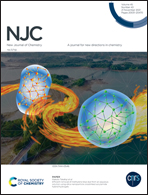A highly selective visual paper-based detector for hydrazine and MCL luminogens based on fluorinated-pyrrole-functionalized triphenylamine†
Abstract
The practicality of portable fluorescent detectors has attracted widespread attention. Herein, a series of luminogens was obtained via integrating pyrrole/fluorinated-pyrrole with triphenylamine in high yield. The emission performance was modified via varying the F and CN substituents on the pyrrole ring. The compounds TPACHO and TPAFCHO, with aldehyde-group-substituted pyrrole, exhibit significant mechanochromic luminescence (MCL) behavior and typical AIEE properties. The compounds TPA2CN and TPA2FCN can efficiently detect liquid and gaseous hydrazine hydrate, and they can achieve paper-based detection through visually clear emission color switching from yellow/orange to blue. The minimum detectable concentration of hydrazine was 10 mM. Moreover, TPA2CN exhibits good inhibitory activity toward human nasopharyngeal tumor cells (CNE1) and it has application prospects in tumor cell detection and biological cell monitoring. Thus, such functionalized paper can be applied as highly selective discriminating test strips for hydrazine hydrate.



 Please wait while we load your content...
Please wait while we load your content...